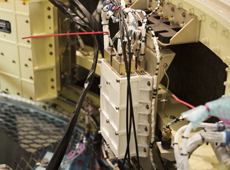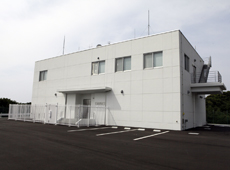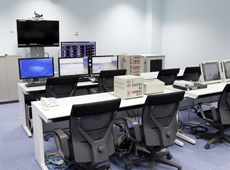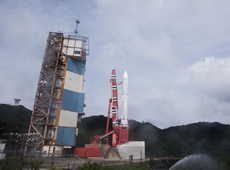
--- Tell us about Epsilon’s autonomous and automatic checkout system.

Artificial intelligence system ROSE, installed on Epsilon (courtesy: JAXA/JOE NISHIZAWA)
The ROSE automatic and autonomous checkout system, which uses artificial intelligence and the rocket’s on-board computer, is installed in the Epsilon Control Center. This, combined with the Launch Control System (LCS), which allows remote control of rocket checkout and launch, streamlines rocket checkouts. The rocket sends information about itself to a computer at the control center. If we see abnormal data, we do a checkout. The capability to do this with just two computers is called mobile control. By having ROSE and the LCS conduct checkouts that had previously required multiple personnel and pieces of equipment to perform, we have reduced the size of the ground crew and sped up the work.
Previously we had ground-based equipment for each of the rocket’s devices; now ROSE collects data from all the devices and sends it to the ground facility. We can then forward that data to other JAXA offices, and to the appropriate manufacturer. For example, IHI Aerospace, the company that built the fuselage, looks at this data at its factory and performs a technical assessment to find out whether there are any signs of defects in the fuselage. The people who perform the technical assessments used to have to come to Uchinoura, but now the network allows them to do their job even if they’re far away.
--- How much time has this system saved?
Not all the time saved is a result of this system’s ingenuity, but we have reduced the time from the delivery of a single-stage rocket to the launch site to launch from 42 days to seven. The system has also enabled us to work on the satellite payload until three hours before launch. After a rocket is placed on the launch pad, we checkput its electronics. In the past, it took a lot of time and effort to connect checkout cables and then do the checkout. Also, final access to the satellite used to be nine hours before launch. After loading the satellite in the rocket, the satellite team wanted to make final preparations and checkouts as close to launch time as they could, and I think we’ve now met their need very well.
--- What difficulties did you have during this launch?

Exterior view of Epsilon launch control center
It was hard to configure the timing so that the system at the ground facility would run an assessment a few seconds after receiving the data from the rocket. Each piece of on-board equipment has its unique properties, and we couldn’t assess them all at once, so we had to precisely configure the timing for each. The system would detect an error if the timing was even just a little bit off, and that would automatically shut down all subsequent operations. At first we just had a string of errors, so then we rearranged the procedures and proceeded with a trial-and-error approach.
--- How did you feel when the timing error delayed the launch?

Interior view of Epsilon launch control center
The cause of the aborted launch was that we didn’t give serious consideration to the 0.07 seconds it took to send a command to the rocket and receive a response. The rocket triggered its own shutdown 19 seconds before launch, but that was because the system had detected a flaw. In other words, it worked properly. That’s why I had very mixed feelings when the media reported the launch had failed due to a system malfunction.
--- Were you happy when the launch succeeded?
After the launch was postponed, we formed an investigative team to examine whether something had functioned incorrectly, and we performed a thorough general review at Uchinoura. That was hard work, so when I saw the launch, part of me felt genuinely moved, while the other part felt relief that the equipment I had worked on had functioned properly.
It was also my first time seeing a solid-fuel rocket launch. I was about 2 km away from the launch site, at the Epsilon Control Center. We could feel the shock from the launch in the building, and I hadn’t expected that it would feel as if my own body was going up, too. I had previously worked on the H-IIA and H-IIB launch site equipment, but at the Tanegashima Space Center the launch control room is underground, so I didn’t feel the shock of the launches there. If I ever get the chance, I definitely want to watch an Epsilon launch from outside the building.
--- How are you planning to improve upon the automatic and autonomous checkout system in the future?

Epsilon just prior to launch (courtesy: JAXA/JOE NISHIZAWA)
We had implemented the “automatic” checkout in the prototype, but hadn’t utilized the “autonomous” checkout feature yet. The system needs as much data as possible to conduct an accurate technical assessment autonomously, but right now we are still at the stage of collecting basic data. Currently we are using the data we have collected so far to adjust the parameters, so we can determine proper operation and detect malfunctions in the second rocket. An autonomous checkout system becomes more accurate the more data it has, so I think we’ll have to build on what we have through ground tests and launches.
I’d also like to make the system easier to use. For example, sometimes out in the field we have to change our procedures on the spot. When that happens, we have to change various parameters. I’d like us to be able to perform these configuration changes and checks with more flexibility.
--- In the future, will you be able to control automatic and autonomous checkouts remotely as well?
I think that’s difficult due to security concerns. Technically it may be possible, but if we use a public line then it’s conceivable someone from the outside could interfere. But I would like to try to build simple equipment for this, which could be used with a dedicated line.
--- What would you ideal launch control equipment be like?
Equipment useable anywhere, anytime. If we could make a single portable launch controller with an automatic and autonomous checkout feature, then we could launch a rocket anywhere, whether it be at Uchinoura or Tanegashima.
--- What do you think motivates you to do this work?

I guess it’s the liberating feeling I get at the time of launch, or rather when a launch succeeds. The months leading up to the launch are tough, but I overcome the difficulties through my strong desire to somehow make the launch a success. Everyone at the launch site thinks this way. By the time the launch happens, we’ve all been working so hard toward that goal. So when I see the rocket fly up toward space, all the tension I’ve been carrying goes away. That moment is something I will love forever.
--- Please give us a message for young people.
I’d like you kids to do things in brand new ways and come up with lots of ideas. Also, I want you to believe that you can do anything if you just put your mind to it. To be honest, when I first heard about the automatic and autonomous checkout system, I thought, “What? Can that be done?” But as I got to work on it, I started to feel very much more certain that we would accomplish it, rather than wondering whether or not we could. I think there was probably some sort of fire in me or something. (Laughs.) I’d like you to find something, even just one thing, that gets you all fired up like that.
Associate Senior Engineer, Epsilon Rocket Project Team, Space Transportation Mission Directorate, JAXA
Mr. Hirose joined the National Space Development Agency (NASDA, now part of JAXA) in 1986. There, he was involved in developing launch-site equipment for the H-II, H-IIA and H-IIB launch vehicles. In 2011 he transferred to the Epsilon Launch Vehicle Project Team. Mr. Hirose is in charge of developing the Launch Control System and other launch site equipment.
Making good rockets requires more simplicity!
Epsilon Technology: A Link to the Future
Epsilon: A Soft and Comfortable Ride
The Anytime, Anywhere Rocket
Building a Versatile Rocket
